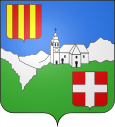Mont-Saxonnex
| Mont-Saxonnex | ||
|---|---|---|

|
|
|
| region | Auvergne-Rhône-Alpes | |
| Department | Haute-Savoie | |
| Arrondissement | Bonneville | |
| Canton | Cluses | |
| Community association | Cluses-Arve et Montagnes | |
| Coordinates | 46 ° 3 ' N , 6 ° 29' E | |
| height | 580-2,433 m | |
| surface | 26.28 km 2 | |
| Residents | 1,668 (January 1, 2017) | |
| Population density | 63 inhabitants / km 2 | |
| Post Code | 74130 | |
| INSEE code | 74189 | |
| Website | www.mont-saxonnex.fr | |
Mont-Saxonnex is a French commune in the department of Haute-Savoie in the region of Auvergne Rhône-Alpes .
geography
Mont-Saxonnex is located at 980 m , west of Cluses , about 31 kilometers southeast of the city of Geneva (as the crow flies). The mountain village extends on a panoramic terrace south of the Arve valley around 500 m above the valley floor, in the northern Bornes Alps (part of the Savoy Alps ) at the northern foot of the Chaîne du Bargy, in Faucigny .
The area of the 26.28 km² municipal area includes a section of the Bornes Alps. The northern border runs along the steep slope below the terrace of Mont-Saxonnex. From here the community area extends to the south and includes the protrusions and heights in the area of Mont-Saxonnex as well as the entire upper part of the catchment area of the Bronze , a side stream of the Arve . The Valley of the Bronze is flanked in the west by the Les Combes ridge (up to 1724 m ) and the high plateau at Col de Cenise, in the south and southeast by the rugged limestone peaks of the Chaîne du Bargy. The southern border is formed by the main peaks of this mountain range, namely from west to east the Pointe Blanche (with 2437 m the highest elevation of Mont-Saxonnex), the Pointe du Midi ( 2364 m ) and the Bargy ( 2299 m ). The western half of the Lac Bénit mountain lake at the foot of the Chaîne du Bargy also belongs to the municipality.
In addition to the actual village, Mont-Saxonnex also includes various settlements and hamlets as well as numerous holiday homes and farms, including:
- Pincru ( 950 m ) in a hollow on Bronze
- La Balme ( 840 m ) on a terrace above the Arve valley
- Chamoules ( 810 m ) on a terrace above the Arve valley
- Le Bourgeal ( 1050 m ) on the terrace of Mont-Saxonnex
- Alloup ( 1060 m ) on a ledge above Marnaz
- Mollesule ( 1250 m ) on the bronze at the foot of the Chaîne du Bargy
Neighboring municipalities to Mont-Saxonnex are Bonneville and Vougy in the north, Marnaz in the east, Le Reposoir in the south and Glières-Val-de-Borne and Brizon in the west.
history
The parish of Mont-Saxonnex was founded in the 12th century. The place is mentioned for the first time in 1298 under the name Mons de Sersunay . This name changed over the centuries via Mont Sersonay (1365), Mont de Sarsonay (1495), Mont Sassonay or Sassonex (1606) to Mont Saxonnex (1652). The place name is derived from the Latin words mons saxorum nigrorum (mountain of black rocks).
In the Middle Ages , Mont-Saxonnex belonged to the Faucigny domain. As part of the Dauphiné, the place came to France in 1349, but was given to the Counts of Savoy in an exchange of countries in the Treaty of Paris in 1355 . Thereafter, Mont-Saxonnex shared the fate of Savoy .
Attractions
The village church of Notre Dame de l'Assomption stands on a rocky promontory that offers an impressive view of the Arve valley. It was rebuilt in 1829 on the site of an earlier church in neoclassicism . The chapel in Pincru was built in 1664. Also worth mentioning is the votive chapel of La Gouille.
population
| Population development | |
|---|---|
| year | Residents |
| 1962 | 755 |
| 1968 | 675 |
| 1975 | 625 |
| 1982 | 645 |
| 1990 | 880 |
| 1999 | 1,150 |
| 2005 | 1,477 |
With 1668 inhabitants (as of January 1, 2017), Mont-Saxonnex is one of the smaller communities in the Haute-Savoie department. In the course of the 20th century the number of inhabitants decreased continuously due to strong emigration (1901 in Mont-Saxonnex there were still 1408 inhabitants). Since the beginning of the 1980s, however, there has been a significant increase in population. The population growth has been particularly strong since 2000, so that the previous high was exceeded in 2005.
Economy and Infrastructure
Until well into the 20th century, Mont-Saxonnex was primarily a village characterized by agriculture and alpine farming. Today there are various small business enterprises. Many workers are commuters who work in the larger towns in the area. In the last few decades, Mont-Saxonnex has developed into a tourist destination and local recreation destination, which has given it a significant economic boom. The municipality specializes in both summer tourism and winter tourism (mountain railways and ski lifts).
The village is very well developed in terms of traffic. Mont-Saxonnex can be reached from both Thuet near Bonneville and Marnaz. Another road connection is with Brizon. The closest connection to the A40 motorway is around eight km away.

